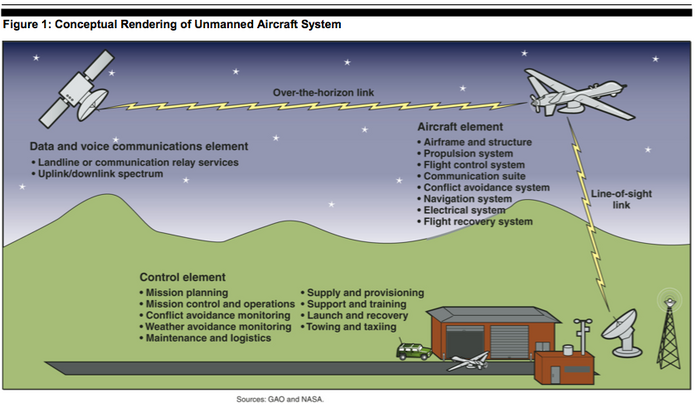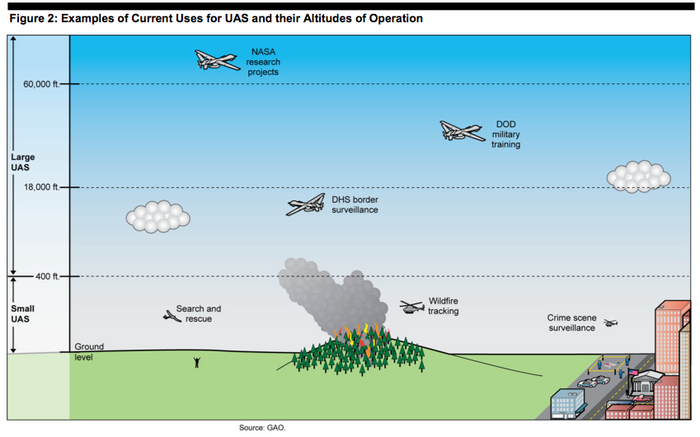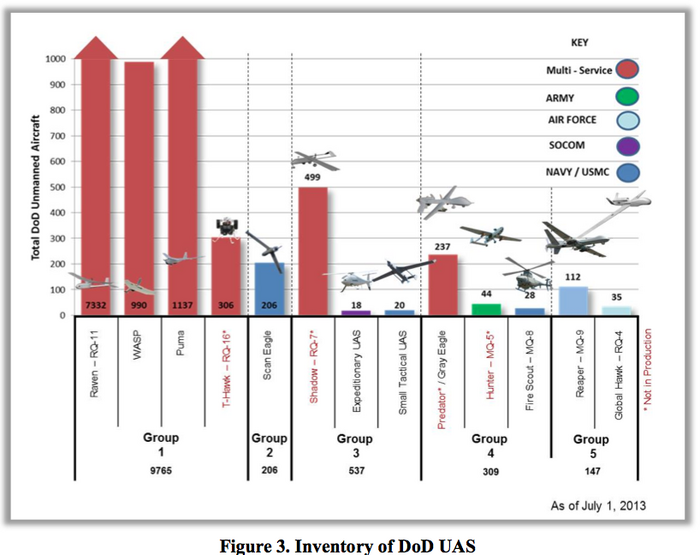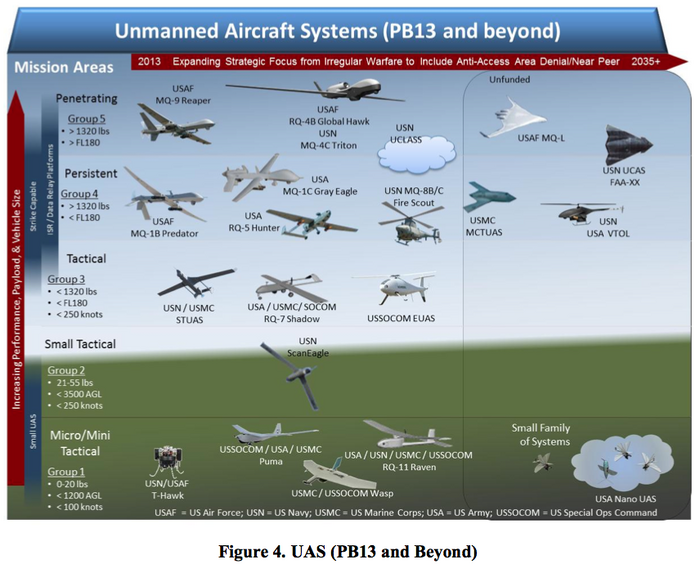m (→See also) Tag: sourceedit |
No edit summary Tag: Visual edit |
||
| Line 5: | Line 5: | ||
{{Quote|comprises an aircraft with no onboard pilot, controlled from a [[remote]] operating station.<ref>[[Unmanned Aircraft Systems (UAS): Commercial Outlook for a New Industry]], at 1.</ref>}} |
{{Quote|comprises an aircraft with no onboard pilot, controlled from a [[remote]] operating station.<ref>[[Unmanned Aircraft Systems (UAS): Commercial Outlook for a New Industry]], at 1.</ref>}} |
||
| − | {{Quote|is [t]hat [[system]] whose [[component]]s include the necessary [[equipment]], [[network]], and personnel to control an [[unmanned aircraft]].<ref>DOD Dictionary of Military Terms ([http://www.dtic.mil/doctrine/dod_dictionary/ full-text]).</ref>}} |
+ | {{Quote|is [t]hat [[system]] whose [[component]]s include the necessary [[equipment]], [[network]], and personnel to control an [[unmanned aircraft]].<ref>DOD Dictionary of Military Terms ([http://archive.today/2012.07.24-183035/http://www.dtic.mil/doctrine/dod_dictionary/ full-text]).</ref>}} |
{{Quote|comprises individual 'System Elements' consisting of the [[Unmanned Aircraft]] ([[UA]]) and any other System Elements necessary to enable flight, such as a [[Remote Pilot Station]], [[Communication Link]] and [[Launch and Recovery]] Element. There may be multiple [[UA]]s, [[RPS]] or [[Launch and Recovery]] Elements within a [[UAS]].<ref>[[Unmanned Aircraft System Operations in UK Airspace–Guidance]], at 5.</ref>}} |
{{Quote|comprises individual 'System Elements' consisting of the [[Unmanned Aircraft]] ([[UA]]) and any other System Elements necessary to enable flight, such as a [[Remote Pilot Station]], [[Communication Link]] and [[Launch and Recovery]] Element. There may be multiple [[UA]]s, [[RPS]] or [[Launch and Recovery]] Elements within a [[UAS]].<ref>[[Unmanned Aircraft System Operations in UK Airspace–Guidance]], at 5.</ref>}} |
||
| Line 11: | Line 11: | ||
{{Quote|[is] an [[unmanned aircraft]] and its associated elements related to safe operations, which may include control stations (ground-, ship-, or air-based), control links, support equipment, payloads, flight termination systems, and launch/recovery equipment.<ref>[[Integration of Civil Unmanned Aircraft Systems (UAS) in the National Airspace System (NAS) Roadmap]], App. B, Glossary, at 46.</ref>}} |
{{Quote|[is] an [[unmanned aircraft]] and its associated elements related to safe operations, which may include control stations (ground-, ship-, or air-based), control links, support equipment, payloads, flight termination systems, and launch/recovery equipment.<ref>[[Integration of Civil Unmanned Aircraft Systems (UAS) in the National Airspace System (NAS) Roadmap]], App. B, Glossary, at 46.</ref>}} |
||
| − | "These aircraft are also referred to as [[unmanned aircraft vehicle]]s, [[remotely piloted aircraft]], or [[drone]]s. They do not carry a pilot aboard, but instead operate on pre-programmed routes or are manually controlled by commands from pilot-operated [[ground control station]]s |
+ | "These aircraft are also referred to as [[unmanned aircraft vehicle]]s, [[remotely piloted aircraft]], or [[drone]]s. They do not carry a pilot aboard, but instead operate on pre-programmed routes or are manually controlled by commands from pilot-operated [[ground control station]]s. UASs are being used for law enforcement, national defense, academic research, commercial, and recreational purposes."<ref>[[Unmanned Aerial Systems: Efforts Made toward Integration into the National Airspace Continue, but Many Actions Still Required]], at 1 n.1.</ref> |
== Overview == |
== Overview == |
||
| Line 32: | Line 32: | ||
As noted by the FAA: |
As noted by the FAA: |
||
| − | {{Quote|The use of UAS has increased significantly in the United States. From agricultural [[monitor]]ing and [[border surveillance]] to local crime scene investigations, search and rescue missions, disaster response (e.g., wildfires and floods), and military training, UAS provide a wide variety of operational, societal, and economic benefits to its diverse group of [[user]]s |
+ | {{Quote|The use of UAS has increased significantly in the United States. From agricultural [[monitor]]ing and [[border surveillance]] to local crime scene investigations, search and rescue missions, disaster response (e.g., wildfires and floods), and military training, UAS provide a wide variety of operational, societal, and economic benefits to its diverse group of [[user]]s. However, as the demand for [[UAS]] increases, concerns regarding how [[UAS]] will impact existing aviation grow stronger, especially in terms of safety, [[privacy]], [[frequency]] crowding, and airspace congestion.<ref>[[Unmanned Aircraft Systems (UAS) Comprehensive Plan: A Report on the Nation's UAS Path Forward]], at 5.</ref>}} |
"UAS include the [[data link]]s and other communications systems used to connect the UAS control station, unmanned aircraft, and other elements of the [[NAS]], such as ATM systems and human operators. Unless otherwise specified, UAS are assumed to have no humans on board either as flight crew or as passengers."<ref>[[Autonomy Research for Civil Aviation: Toward a New Era of Flight]], at 3.</ref> |
"UAS include the [[data link]]s and other communications systems used to connect the UAS control station, unmanned aircraft, and other elements of the [[NAS]], such as ATM systems and human operators. Unless otherwise specified, UAS are assumed to have no humans on board either as flight crew or as passengers."<ref>[[Autonomy Research for Civil Aviation: Toward a New Era of Flight]], at 3.</ref> |
||
| Line 50: | Line 50: | ||
The [[Federal Aviation Administration]]'s ([[FAA]]'s) roadmap for integrating unmanned aircraft systems ([[UAS]]) in civil airspace has concluded that |
The [[Federal Aviation Administration]]'s ([[FAA]]'s) roadmap for integrating unmanned aircraft systems ([[UAS]]) in civil airspace has concluded that |
||
| − | {{Quote|harmonized [[radio spectrum]] is needed for [[UAS]] control and [[communications link]]s to help ensure their protection from unintentional [[radio frequency interference]], to help ensure adequate [[spectral bandwidth]] is available for meeting the projected [[command and control]] [[link]] capacity demands, and to facilitate operation of [[UAS]] across international borders. While [[spectrum]] is also needed for [[beyond-line-of-sight]] [[command and control]] [[link]]s, the initial focus was on [[radio]] [[line-of-sight]] for civil [[UAS]] because demand for [[line-of-sight]] [[link]]s is expected to be greater.<ref>[[Federal Aviation Administration]], Integration of Civil Unmanned Aircraft Systems (UAS) in the National Airspace System (NAS) — Roadmap 56 (1st ed. Nov. 7, 2012) ([http://www.faa.gov/about/initiatives/uas/media/uas_roadmap_2013.pdf full-text]).</ref>}} |
+ | {{Quote|harmonized [[radio spectrum]] is needed for [[UAS]] control and [[communications link]]s to help ensure their protection from unintentional [[radio frequency interference]], to help ensure adequate [[spectral bandwidth]] is available for meeting the projected [[command and control]] [[link]] capacity demands, and to facilitate operation of [[UAS]] across international borders. While [[spectrum]] is also needed for [[beyond-line-of-sight]] [[command and control]] [[link]]s, the initial focus was on [[radio]] [[line-of-sight]] for civil [[UAS]] because demand for [[line-of-sight]] [[link]]s is expected to be greater.<ref>[[Federal Aviation Administration]], Integration of Civil Unmanned Aircraft Systems (UAS) in the National Airspace System (NAS) — Roadmap 56 (1st ed. Nov. 7, 2012) ([https://web.archive.org/web/20131114212047/http://www.faa.gov/about/initiatives/uas/media/uas_roadmap_2013.pdf full-text]).</ref>}} |
The proliferation of [[remotely piloted]] [[UAS]], as they are currently operated, will increase the demand for [[communications]] and [[data acquisition]]. These [[system]]s use [[communications]]/[[data link]]s to [[connect]] [[remotely]] located pilots, aircraft, and [[air traffic controller]]s. Managing the [[transmission]] of [[video]] and airborne weather [[radar]] is key to maximizing available [[bandwidth]]. The demand for both of these [[high-bandwidth]] [[system]]s peaks during the departure and arrival phase of flight. [[Unmanned aircraft]] in a fully [[autonomous]] mode would greatly reduce the demand for [[bandwidth]] associated with aircraft operations. Even so, some [[UAS]] missions will involve [[real-time]] [[streaming video]] and/or [[sensor data]], which could still test the limits of available [[communications]] [[bandwidth]]. |
The proliferation of [[remotely piloted]] [[UAS]], as they are currently operated, will increase the demand for [[communications]] and [[data acquisition]]. These [[system]]s use [[communications]]/[[data link]]s to [[connect]] [[remotely]] located pilots, aircraft, and [[air traffic controller]]s. Managing the [[transmission]] of [[video]] and airborne weather [[radar]] is key to maximizing available [[bandwidth]]. The demand for both of these [[high-bandwidth]] [[system]]s peaks during the departure and arrival phase of flight. [[Unmanned aircraft]] in a fully [[autonomous]] mode would greatly reduce the demand for [[bandwidth]] associated with aircraft operations. Even so, some [[UAS]] missions will involve [[real-time]] [[streaming video]] and/or [[sensor data]], which could still test the limits of available [[communications]] [[bandwidth]]. |
||
Latest revision as of 00:28, 4 August 2020
Definitions[]
An unmanned aircraft system (UAS)
| “ | comprises an aircraft with no onboard pilot, controlled from a remote operating station.[1] | ” |
| “ | is [t]hat system whose components include the necessary equipment, network, and personnel to control an unmanned aircraft.[2] | ” |
| “ | comprises individual 'System Elements' consisting of the Unmanned Aircraft (UA) and any other System Elements necessary to enable flight, such as a Remote Pilot Station, Communication Link and Launch and Recovery Element. There may be multiple UAs, RPS or Launch and Recovery Elements within a UAS.[3] | ” |
| “ | [is] an unmanned aircraft and its associated elements related to safe operations, which may include control stations (ground-, ship-, or air-based), control links, support equipment, payloads, flight termination systems, and launch/recovery equipment.[4] | ” |
"These aircraft are also referred to as unmanned aircraft vehicles, remotely piloted aircraft, or drones. They do not carry a pilot aboard, but instead operate on pre-programmed routes or are manually controlled by commands from pilot-operated ground control stations. UASs are being used for law enforcement, national defense, academic research, commercial, and recreational purposes."[5]
Overview[]
Figure 1 shows the components of a UAS.
UAS fly at all levels of airspace, generally based on their size. UAS are typically described in terms of weight, endurance, purpose of use, and altitude of operation.
- "Small" UAS typically weigh less than 55 pounds, fly below 400 feet above ground level, can stay airborne for several hours, and can be used for reconnaissance, inspection, and surveillance.[6] However, some small UAS can have longer endurance and can operate beyond line-of-sight capability.
- "Large" UAS, depending on their size and mission, generally fly at altitudes up to or greater than 60,000 feet, some can remain airborne for multiple days, and are generally used for the purposes of surveillance, data gathering, and communications relay.
Figure 2 provides examples of UAS and the altitudes at which they operate. Below 18,000 feet, there is a wide variety of types of aircraft, including those taking off and landing, and levels of activity at different altitudes which impacts the integration of UAS into the national airspace system.
This variety of flight activity will require coordination with various state and federal agencies, e.g., law enforcement, agricultural, environmental, and emergency response. The activity in this airspace is projected to experience significant growth in small independent UAS utilization because of the potential economic benefits for the users of UAS. According to an industry forecast, the market for government and commercial use[7] of UAS is expected to grow, with small UAS having the greatest growth potential.[8]
As noted by the FAA:
| “ | The use of UAS has increased significantly in the United States. From agricultural monitoring and border surveillance to local crime scene investigations, search and rescue missions, disaster response (e.g., wildfires and floods), and military training, UAS provide a wide variety of operational, societal, and economic benefits to its diverse group of users. However, as the demand for UAS increases, concerns regarding how UAS will impact existing aviation grow stronger, especially in terms of safety, privacy, frequency crowding, and airspace congestion.[9] | ” |
"UAS include the data links and other communications systems used to connect the UAS control station, unmanned aircraft, and other elements of the NAS, such as ATM systems and human operators. Unless otherwise specified, UAS are assumed to have no humans on board either as flight crew or as passengers."[10]
FAA authorization[]
Currently, the FAA authorizes military and non-military (academic institutions; federal, state, and local governments including law enforcement entities; and private sector entities) entities to provide UAS operations on a limited basis after conducting a case-by-case safety review. Only federal, state, and local government agencies can apply for and be granted a Certificate of Waiver or Cerificate of Authorization (COA); private sector entities (civil operators) may apply for special airworthiness certificates in the experimental category that allows them to operate UAS.[11]
The FAA has stated that
| “ | A UAS is an 'aircraft' as defined in the FAA's authorizing statutes and is therefore subject to regulation by the FAA. 49 U.S.C. §40102(a)(6) defines an 'aircraft' as 'any contrivance invented, used, or designed to navigate or fly in the air.' The FAA's regulations (14 C.F.R. §1.1) similarly define an 'aircraft' as 'a device that is used or intended to be used for flight in the air.' Because an unmanned aircraft is a contrivance/device that is invented, used, and designed to fly in the air, it meets the definition of 'aircraft.' The FAA has promulgated regulations that apply to the operation of all aircraft, whether manned or unmanned, and irrespective of the altitude at which the aircraft is operating. For example, 14 C.F.R. §91.13 prohibits any person from operating an aircraft in a careless or reckless manner so as to endanger the life or property of another.[12] | ” |
"In February 2015, the FAA issued a notice of proposed rulemaking as a step toward regulations that will spell out safety rules for nonrecreational UAS under 55 pounds. The notice proposes to limit flights to daylight hours and visual-line-of-sight operations. The FAA also proposes to require a single operator for each drone, which could limit the commercial viability of some potential uses of UAS. The notice also specifies height restrictions, operator certification requirements, optional use of a visual observer, aircraft registration and marking, and operational limits. Final rules may not be issued by FAA until late 2016 or early 2017."[13]
Spectrum allocation[]
The Federal Aviation Administration's (FAA's) roadmap for integrating unmanned aircraft systems (UAS) in civil airspace has concluded that
| “ | harmonized radio spectrum is needed for UAS control and communications links to help ensure their protection from unintentional radio frequency interference, to help ensure adequate spectral bandwidth is available for meeting the projected command and control link capacity demands, and to facilitate operation of UAS across international borders. While spectrum is also needed for beyond-line-of-sight command and control links, the initial focus was on radio line-of-sight for civil UAS because demand for line-of-sight links is expected to be greater.[14] | ” |
The proliferation of remotely piloted UAS, as they are currently operated, will increase the demand for communications and data acquisition. These systems use communications/data links to connect remotely located pilots, aircraft, and air traffic controllers. Managing the transmission of video and airborne weather radar is key to maximizing available bandwidth. The demand for both of these high-bandwidth systems peaks during the departure and arrival phase of flight. Unmanned aircraft in a fully autonomous mode would greatly reduce the demand for bandwidth associated with aircraft operations. Even so, some UAS missions will involve real-time streaming video and/or sensor data, which could still test the limits of available communications bandwidth.
U.S. military[]
"DOD's UAS portfolio is divided into five general groups based upon aircraft weight, speed, and operating altitude. Group 1 UAS are the smallest systems, generally weighing up to 20 pounds and operating below 1,200 feet. Group 5 UAS are the largest systems, weighing over 1,320 pounds at operating higher than 18,000 feet."[15] See Figure 3.
Looking toward the future, modernization of current capabilities will dominate, and limited development of new capabilities will likely focus on smaller numbers of higher end platforms capable of operating in more contested air environments. With fewer new systems in development and many future projects being deferred, the planning outlook toward future systems is much more conservative. See Figure 4.
References[]
- ↑ Unmanned Aircraft Systems (UAS): Commercial Outlook for a New Industry, at 1.
- ↑ DOD Dictionary of Military Terms (full-text).
- ↑ Unmanned Aircraft System Operations in UK Airspace–Guidance, at 5.
- ↑ Integration of Civil Unmanned Aircraft Systems (UAS) in the National Airspace System (NAS) Roadmap, App. B, Glossary, at 46.
- ↑ Unmanned Aerial Systems: Efforts Made toward Integration into the National Airspace Continue, but Many Actions Still Required, at 1 n.1.
- ↑ According to an industry association, small UAS are expected to comprise the majority of UAS that will operate in the national airspace system.
- ↑ "Examples of commercial use could include delivering packages, precision agriculture, and power line inspection. According to a UAS industry association, these industries represent examples of commercial potential that in the first decade following integration will contribute to more than 100,000 jobs and $82 billion in economic impact." Unmanned Aerial Systems: Efforts Made toward Integration into the National Airspace Continue, but Many Actions Still Required, at 1 n.3.
- ↑ Teal Group Corp., World Unmanned Aerial Vehicle Systems (Fairfax, VA 2012).
- ↑ Unmanned Aircraft Systems (UAS) Comprehensive Plan: A Report on the Nation's UAS Path Forward, at 5.
- ↑ Autonomy Research for Civil Aviation: Toward a New Era of Flight, at 3.
- ↑ COAs and special airworthiness certifications in the experimental category represent exceptions to the usual aircraft certification process. The FAA examines the facts and circumstances of a proposed UAS to ensure that the prospective pilot has acceptably mitigated the safety risks.
- ↑ Law Enforcement Guidance for Suspected Unauthorized UAS Operations, at 2.
- ↑ Unmanned Aircraft Systems (UAS): Commercial Outlook for a New Industry, at 12.
- ↑ Federal Aviation Administration, Integration of Civil Unmanned Aircraft Systems (UAS) in the National Airspace System (NAS) — Roadmap 56 (1st ed. Nov. 7, 2012) (full-text).
- ↑ Defense Acquisitions: DOD Efforts to Adopt Open Systems for Its Unmanned Aircraft Systems Have Progressed Slowly, at 2.
Sources[]
- Unmanned Aerial Systems: Efforts Made toward Integration into the National Airspace Continue, but Many Actions Still Required, at 1.
- Unmanned Aircraft Systems: Measuring Progress and Addressing Potential Privacy Concerns Would Facilitate Integration into the National Airspace System, at 1, 5-7, 11.
- Unmanned Aircraft Systems (UAS): Commercial Outlook for a New Industry, at 12.
- "Spectrum allocation" section: Autonomy Research for Civil Aviation: Toward a New Era of Flight, at 33-34.
See also[]
- DHS Privacy, Civil Rights, and Civil Liberties Working Group on UAS
- Fact Sheet-Unmanned Aircraft Systems (UAS)
- Integration of Civil Unmanned Aircraft Systems (UAS) in the National Airspace System (NAS) Roadmap
- Remotely piloted aircraft
- UAS Aviation Rulemaking Committee
- UAS Executive Committee
- UAS Integration Office
- Unmanned Aerial Systems: FAA Continues Progress Toward Integration into the National Airspace
- Unmanned aerial vehicle
- Unmanned aircraft
- Unmanned Aircraft Systems: Measuring Progress and Addressing Potential Privacy Concerns Would Facilitate Integration into the National Airspace System



